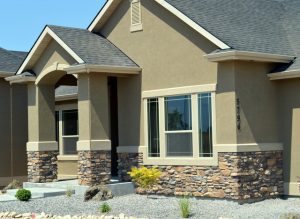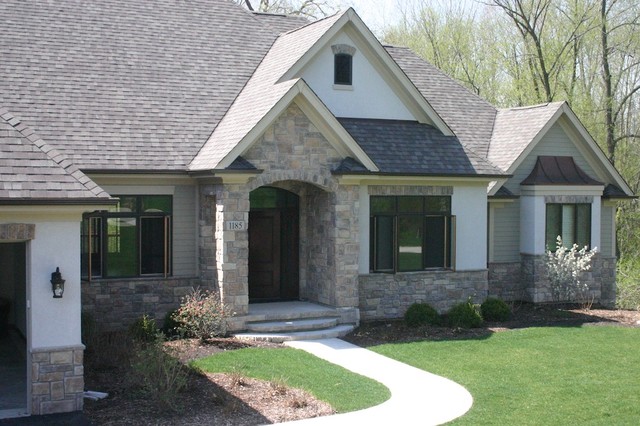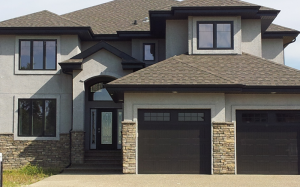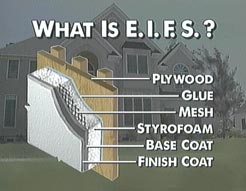Gambrick Construction offers high-quality siding products for installation in residential construction and commercial construction projects in New Jersey including stucco, acrylic stucco and EIFS.
Stucco

The three main types of Stucco are:
While stucco’s siding costs have dropped with improved manufacturing and distribution channels, this type of cladding can still be more expensive than others. This is offset by its durability and the fact that siding replacement will never be a necessity. In certain areas, synthetic stucco may be available, but realize that this is not as durable as the real product.
Modern stucco may also consist of a proprietary mix of additives including fibers and synthetic acrylics that add strength and flexibility. Modern synthetic stucco can be applied as one base layer and a finish layer, which is thinner and faster to apply, compared to the traditional application of three-coat stucco.
As with any cement-based material, stucco must be reinforced to resist movement cracking. Plastic or wire mesh lath, attached with nails or screws to the structural framing, is embedded into the base coat to provided stiffening for the stucco. Often, smaller surface cracks that may appear are covered with an application of one of a variety of pre-mixed acrylic finishes. Flexible acrylic finishes have the ability to stretch and bridge over cracks, improving appearance and limiting the passage of moisture behind the stucco.
Where stucco is to be applied to a structure of wood-framing or light-gauge steel framing, the framing is protected from moisture damage by applying a vapor-permeable, water-resistant weather barrier; typically an asphalt-saturated paper or one of a variety of manufactured plastic-based sheets, known as “building wraps” or “stucco wraps”. The property of this barrier protects the framing from rain and moisture, and also allows free passage of any water vapor generated inside the building to escape through the wall.
Stucco as Siding

Colors to Match Any Style
The stucco itself can be colored, as well as the common acrylic finish. Any desired color can be mixed and applied over stucco to complement an existing scheme or completely remodel the building. When combined with stone coping or masonry cladding around windows and doors, very remarkable effects can be achieved.
Conventional Stucco
Stucco is a surface coating that provides superior qualities that is adaptable over a wide variety of surfaces. Stucco will provide a strong, firm, fire and weather resistant membrane. Stucco will not deteriorate rapidly, resists rot and fungus, and has proven to be a durable wall covering in both warm and very cold climates. Possessing properties similar to reinforced concrete, stucco provides long-term protection to any surface. It is economical and requires little maintenance. Stucco provides several distinct finishes, and all stucco finishes include a wide variety of texture and color options.
Although stucco-sided homes became popular in twentieth century America, the concept of using cement mixtures in architecture goes back to ancient times. Part of the traditional construction methods in the Mediterranean area, stucco (or mortars), a mixture of lime and sand, has been used for centuries for wall finishing. ‘Stucco’ refers to the branch of the plastering industry that manipulates Portland cement based mortars, usually on exterior surfaces.
Why is stucco also called “Portland cement”? “Portland” does not refer to a geographic location. Instead, it refers to a kind of hard stone “Portland stone” that a young bricklayer, Joseph Aspdin, of Leeds, England, was trying to imitate over 150 years ago. Aspdin wondered why some kind of exterior surfacing couldn’t be used to match the Portland stone-the durable stone that was so popular in those days. He experimented with different lime stones and clays and finally found a way to create hydraulic cement-a cement that hardens even under water and is not affected by exposure to water. Since the stone he was working with was such an inspiration to him, he patented the product as “Portland cement” in 1824.
The first record of Portland cement in the United States was in 1868. European manufacturers began shipping it here as ballast in huge steam ships at very low freight rates. Portland cement production in the United States began in the 1870’s. Today millions of tons are used annually; predominately for concrete, but only a small percentage of the total output is used in the plastering industry.
Modern mortar (lime, sand, cement, and water) is even more resistant and it is usually called European Stucco or Real stucco. Other terms used for European (real) stucco are: old stucco, traditional stucco, and conventional stucco.
Stucco can be considered as a component of a structure’s wall and ceiling assembly. It is usually either the last, or next to last, element to be installed. Stucco is selected because it possesses characteristics, which no other component of the wall assembly can provide. Among its major functions, stucco serves as a refining element, as it can conceal and correct minor deviations in the alignment of the other wall system components, and provide a base for decoration.
Walls made of genuine stucco sound solid when tapped and will be less likely to suffer damage from a hard blow. Also, genuine stucco holds up well in wet conditions. Although it is porous and will absorb moisture, it will dry easily, limiting damage to the structure.
Stucco components:
- substrate (wood, concrete, plaster, gypsum sheathing)
- water barrier (building paper)
- metal lath
- base coat(s) (scratch coat & brown coat)
- finish coat
Acrylic Stucco

Acrylic Stucco is designed to coat a variety of surface structures on metal, wood, stone, concrete, fiberglass or composites without any negative health concerns. With a large assortment of colors, it sure to beautify a home’s appearance while providing a very attractive, durable surface for many years. It breathes and Acrylic Stucco can flex with the substrate without cracking, giving years of maintenance-free service. It has added mildewcide in the formula to guard against the growth.
Exterior Insulation & Finish System (EIFS)

In additional to superior energy efficiency, Outsulation delivers design freedom, durability, beauty and cost effectiveness. EIFS finishes are available in a wide variety of colors and textures, giving the building owner unlimited choices. They can emulate brick, granite, stucco, limestone, precast and more.
We all would like to make our environment cleaner and healthier. EIFS are energy efficient exterior wall systems that leave a tiny environmental footprint on the globe with a significant energy savings benefit for you.
Gambrick Construction’s exterior insulation and finish systems consist of the following components:
- Expanded polystyrene (EPS) insulation board- Increased Wall Insulation R-Value
- Fiberglass reinforced base coat- Increased Wall Strength
- Textured acrylic finish and architectural shapes- Increased Wall Beauty
- These components can be attached to an approved substrate or installed over a liquid applied, air and weather barrier, for even more protection.
By placing the insulation on the OUTSIDE of the building, air leaks are sealed and thermal bridging (heat exchange through wood or metal studs) is virtually eliminated, so you keep more of your conditioned air inside.
Why is this important to you? If you live in a cooler climate, an Outsulation system will keep the warm air that you have heated inside; if you live in a warmer climate, it will keep the cool air that you have air-conditioned inside – Saving you money!
Gambrick Construction can work with you to both stay within your budget and also create a truly unique and permanent finish for your home or business renovation or construction.

